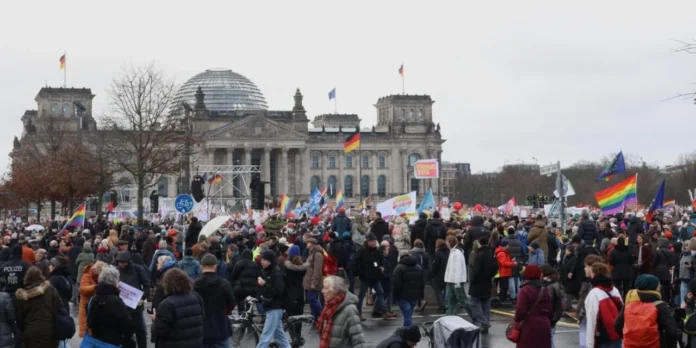Introduction
Germany protests are making headlines as hundreds of thousands take to the streets to oppose right-wing extremism and advocate for democracy. In cities across the country, demonstrators are voicing concerns over rising nationalism and political alliances that blur traditional boundaries. This article explores the scale, impact, and motivations behind these protests while highlighting the key players involved and the broader historical context fueling the unrest.
Why Germany Is Protesting
The recent wave of demonstrations stems from political developments that have raised alarms among pro-democracy advocates. The controversy began when the conservative CDU/CSU alliance passed a non-binding migration reform motion with the backing of the far-right Alternative for Germany (AfD). The collaboration sparked outrage, as many view it as a dangerous shift toward normalizing far-right politics in Germany. Critics argue that this alliance represents a blurring of traditional political boundaries, undermining democratic principles that have long kept extremist factions at bay.
Record-Breaking Turnouts Across Major Cities
Munich: 250,000 Protest for Democracy
On Saturday, Munich witnessed a historic turnout of 250,000 demonstrators (organizers estimate 320,000). Protesters gathered at Theresienwiese—the famous Oktoberfest grounds—marching under banners promoting diversity, human dignity, and democracy. Civil society organizations, including the Munich Film Festival, church groups, and Bayern Munich football club, supported the event. This level of mobilization is a reflection of deep-seated fears regarding the rise of right-wing extremism in one of Germany’s most influential regions.
Nationwide Mobilization
Other cities also saw remarkable participation:
- Nuremberg: 20,000 people, including families and young activists, gathered at Kornmarkt Square, chanting, “We are many.”
- Frankfurt & Stuttgart: Thousands participated in solidarity marches, demonstrating that opposition to extremism is widespread across the country.
- Rostock: The rallying cry, “All against fascism – Rostock stands together!” was used by 3,000 protesters and has been repeated in other towns.
- Hamburg: Another 3,000 joined demonstrations, highlighting the northern region’s commitment to fighting nationalism.
- Lower Saxony & Bremen: Tens of thousands rallied, including a 35,000-strong march in Bremen titled “Bremen sticks together.” The event featured speeches from local leaders, historians, and activists drawing parallels between current events and Germany’s 20th-century past.
- Hanover: 24,000 attended a rally organized by the “Grandmas Against the Right” initiative, underscoring the generational unity in the fight for democracy.
The Political Controversy Behind the Protests

The CDU/CSU leader Friedrich Merz is at the center of this political storm. His alliance’s motion passed thanks to AfD votes, breaking the long-standing “firewall” preventing cooperation with the far-right. Critics argue this move legitimizes extremist ideologies within mainstream politics. Merz’s decision has been widely condemned by activists and politicians who fear this shift could normalize far-right policies and further divide an already polarized electorate.
Although a second conservative-backed migration bill narrowly failed, Merz remains a top contender for Germany’s next chancellor. Recent polls suggest the controversy has not significantly damaged his party’s support. However, it has energized opposition groups, with many calling for stronger measures to safeguard democratic institutions and ensure that extremist ideologies do not gain further traction.
The Bigger Picture: A Fight for Democracy
Germany’s anti-far-right movement is more than just a reaction to political maneuvers—it represents a broader struggle for democratic values. Civil organizations, activists, and ordinary citizens continue to mobilize against hate, exclusion, and extremism. These protests have drawn comparisons to historic movements, including Germany’s post-war denazification efforts and the widespread anti-Nazi sentiment that emerged after World War II.
Furthermore, these demonstrations align with broader global trends, where nations worldwide are grappling with the resurgence of nationalist and extremist movements. Political analysts suggest that the protests in Germany may serve as a blueprint for other nations looking to combat the rise of authoritarianism and xenophobia in their own societies.
Conclusion
The Germany protests underscore a powerful public rejection of right-wing extremism. As the country heads toward national elections on February 23, these demonstrations signal that many Germans are unwilling to compromise on democracy and human rights. The coming weeks will reveal whether these protests will influence political decision-making or if far-right ideologies continue to gain ground. The protests serve as a crucial reminder that democracy requires constant vigilance, and that citizens play a critical role in shaping their nation’s future.
As history has shown, the actions of ordinary people can have profound consequences. Whether these protests lead to concrete political changes remains to be seen, but they undeniably send a strong message: the fight for democracy is far from over.


